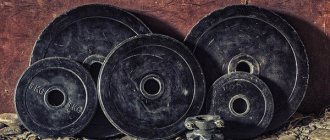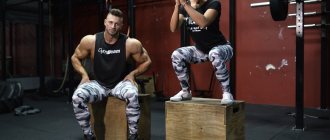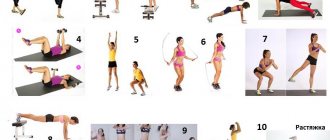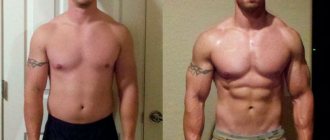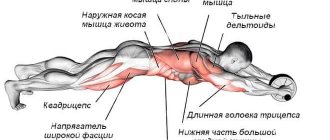Tags: for weight, for experienced, 3 times a week, split
Who is the program for: for those who are ready to train really hard, are ready to have to buy clothes 2-3 sizes larger, for those who can perform most exercises technically competently.
Training principles
10 sets of 10 reps
German volume training involves the athlete performing 10 sets of 10 repetitions per exercise, thereby performing about 100 heavy repetitions. In addition, the weight of the apparatus (barbell or dumbbells) should be the same from the first to the last approach. In order for you to be able to sustain all 10 sets, the weight must be appropriate from the very beginning. For example, let's say you're going to do a barbell bench press. In this case, set the weight with which you reach failure around 20 repetitions. Or, if you know your 1RM (a one-rep max—a weight you can only do one rep with), then load the bar at 60% of your 1RM. After completing the approach, the rest time should be about 60-90 seconds.
Exercise pace
An important condition is also the pace of the exercises. The movement of the projectile during the exercise is divided into 3 phases - concentric, peak contraction and eccentric. Let's take the same bench press as an example. The trajectory of the barbell from the top position to touching the chest is the eccentric phase of the movement, from the chest back up is the concentric phase, in the top position is the peak contraction. Returning to the pace of the exercises, it should be noted that the eccentric phase should be slow (3-4 seconds), that is, lower the barbell to the chest slowly. After touching her chest, you need to squeeze it up twice as fast. The same will apply to other exercises. For example, when doing squats, you first lower yourself with the barbell for four seconds, and then get up in two.
How to determine your level of training
Push-ups are a strength exercise. Before choosing an exercise program, you need to find out your own level of physical fitness.
Take a “lying down” position and do push-ups as many times as possible while maintaining the correct technique. Based on the result, determine your physical fitness.
Men:
- Initial : 8–10 reps.
- Medium : 10–30 reps.
- Advanced : more than 30 per set.
Women:
- Initial : 6–7 reps.
- Medium : 8–15 reps.
- Advanced : more than 15 per set.
Choose multi-joint exercises
It should be remembered that when creating your own training program according to the principles of NOT, not every exercise may be suitable. For 10 sets of 10 reps, you should choose multi-joint movements rather than isolation movements. For example, for training legs, the best option would be squats, but not leg extensions in a machine, or for triceps it would definitely be better to do a bench press with a narrow arm position than extensions with a dumbbell or in a crossover.
Also, there should be one exercise for one muscle group, since the volume of the load is already very large. This is another reason to choose multi-joint exercises that work many muscle fibers.
To work additional muscle groups, you can add three sets of 10-12 repetitions per exercise to your split (we also choose one per muscle group). I will give an example of a training split at the end of this article.
When performing German volume training, forget about any intensification techniques. The amount of work that your muscles will do is already very large, and it is more than enough for good hypertrophy. Aim for 10 sets of 10 reps with one weight. When you can do this, increase the weight by about 5% and try to complete the workout with it.
Analysis
From a pedagogical point of view, the 10x10 system is very accessible due to the small number of variables. A minimum of exercises in the program and practically one single mode (with the exception of small muscle groups: calves and abs). If desired, you can periodically replace the main movement for each muscle group with another, but do not forget that a variety of exercises is not absolutely necessary.
Physiologically, HOT is indeed a fairly gentle scheme that does not cause excessive destruction in practice, which is expressed in the absence of pain after training and rapid recovery.
Increased blood circulation in working muscles increases the likelihood of interaction of anabolic hormone molecules with the corresponding receptors in muscle cells. A number of “steroid gurus” at one time spoke out in favor of volumetric, pump training for “chemist” athletes precisely for this reason - “to pump more hormones into the muscles.” There is a great deal of truth in their words. HOT provides a large volume of load, but at the same time protects the muscles, since out of 10 approaches only a small part of them creates metabolic stress.
However, the system will be useful for “straight people” too. Despite the fact that the first approaches, in terms of the degree of impact on the muscles and the body as a whole, can be classified as warm-up, mechanical stress on the muscles itself can stimulate protein synthesis. There is a phenomenon called signaling processes, or molecular signaling. I quote: “For most cell types, a number of mechanisms have been discovered that mediate the transfer of information from hormone receptors and other humoral regulators, as well as from the synapse and depolarized membrane to nuclear transcription regulators, which determine the selective activity of certain genes, and, accordingly, the selective expression of those or other proteins. In muscle cells, those signaling systems that provide the transmission of information about the changed MECHANICAL state of the cell are especially important. For example, if a fiber actively contracts for a long time, but does not bear a heavy load, then mitochondrial proteins, slow isoforms of myosin, are synthesized. If the fiber contracts, periodically repeating the generation of near-maximal forces, the genes of growth factors are activated, triggering intense protein synthesis on ribosomes.” (A.I. Grigoriev, B.S. Shenkman “Skeletal muscle in an unsupported world”, State Scientific Center “Institute of Medical and Biological Problems of the Russian Academy of Sciences”).
Work with weights of 60-70% of 1 RM is intense enough to stimulate the synthesis of contractile proteins in intermediate and glycolytic muscle fibers even in the absence of metabolic stress, although we obviously will not see great results. But taking into account the fact that the second half of the approaches begins to cause metabolic stress, we will get a full range of effects on the muscle cell and a stronger stimulus for protein synthesis. At the same time, the volume of “stressful” approaches is not large, which will allow the “natural” to ensure the predominance of synthesized protein over that destroyed during the training process. That is, get an increase in hypertrophy.
Thus, the 10x10 system can be recommended for athletes, both those who use pharmaceutical support and those who do not. In the first case, the return will be significantly higher.
Workout plan
This program is built on the principle of supersets (exercises performed without rest, one after another) for antagonist muscles, that is, located parallel to each other and performing actions opposite in direction. For example, biceps and triceps, which are needed for flexion and extension of the arm, respectively. Exercise tempo: 4 and 3 seconds for the eccentric phase and 2 for the concentric phase, for supersets 10x10 and 3x10-12, respectively. It should be performed for 6 weeks.
Read on to see what a weekly split will look like.
Monday – chest and back
- Superset: bench press + pull-ups on the horizontal bar with a wide grip; 10 sets of 10 reps, resting no more than 90 seconds between supersets.
- Superset: lying dumbbell fly + seated horizontal block row to the waist; 3 sets of 10-12 reps, rest between supersets no more than 60 seconds
Tuesday – legs and abs
- Superset: squats with a barbell + lying down curls in the machine; 10 sets of 10 reps, resting no more than 90 seconds between supersets.
- Superset: Lying crunches + seated calf raises; 3 sets of 15-20 repetitions, rest between supersets no more than 60 seconds
Wednesday – rest
Thursday – biceps, triceps and shoulders
- Superset: dips (for triceps) + dumbbell curls for biceps; 10 sets of 10 reps, no more than 90 seconds rest between supersets
- Superset: dumbbell lateral raises + bent over dumbbell lateral raises; 3 sets of 10-12 reps, rest between supersets no more than 60 seconds
Friday - rest
After 6 weeks of this program, you should change the exercises to others, but using the same muscle groups. You also need to change the number of repetitions in 10 sets, that is, now you will not do 10 sets of 10 repetitions, but 6 repetitions. For example, for the first day, the bench press can be replaced with a barbell press on an inclined bench, and pull-ups on a horizontal bar with a vertical block row to the chest. This version of the program can be used until a plateau occurs in strength or mass gain.
A more advanced version of GVT.
This system is called the four percent method. You increase the load by 4 to 5 percent each workout for two workouts in a row, and decrease the target reps by one for each increase in weight.
Read also: Training program for beginners. 8 weeks.
You then decrease the weight by 4 to 5 percent and increase the reps back to the original starting point. Since we're playing with numbers here, let's look at an example that will clearly illustrate this method.
Let's say you can overcome 40 kilograms by performing 10 technical repetitions of barbell curls. But you can’t increase the number of repetitions or weight in this exercise. Here is a sample procedure that will increase all indicators in weighted arm curls:
- Workout 1: 10 sets of 6 reps, weight 50 kg.
- Workout 2: 10 sets of 5 reps, weight 52 kg.
- Workout 3: 10 sets of 4 reps, weight 54 kg.
- Workout 4: 10 sets of 6 reps, weight 52 kg.
- Workout 5: 10 sets of 5 reps, weight 54 kg.
- Workout 6: 10 sets of 4 reps, weight 56-57 kg.
- Workout 7: Challenge day.
Workout 7 - test day. At this point, you should be lifting a 54-kilogram biceps barbell for 10 technical reps. Over the course of six workouts, you've gained almost 10% of your weighted curl strength. Of course, this method can also be used on the bench press, squats, or any other multi-joint exercise in which you want to improve strength.
Let me make it clear again, start with the first program and work on it for six weeks. Lower the intensity by doing the second program for three weeks. Then, if you want to push your strength capabilities to the limit, explode your muscles with the advanced GVT program.
To whom and when are such techniques suitable?
The practical experience of bodybuilders shows that volumetric loads for muscle growth are suitable for people with intermediate and advanced levels of fitness.
If you are a rare owner of a large number of slow fibers in your overall muscle composition, then you can use pump loads on an ongoing basis to stimulate hypertrophy.
But often the use of volumetric training in bodybuilding occurs cyclically, according to the principle of periodization. And this is the most successful way to use them.
For example, at first they train for 4-6 weeks in a strength mode. Here it is recommended to use low-volume, super-intensive schemes (HIT according to Mentzer).
This is followed by 6-8 weeks of training using classical bodybuilding methods. And after that - 4-6 weeks of volume pump training.
Such alternation of diverse techniques guarantees 100% coverage of all types of muscle fibers: fast, intermediate and slow. And this means accelerated weight gain.
Positive features of German volume training
Speaking seriously, one cannot fail to note the positive features of German volumetric training, which make it one of the most effective training systems. Here they are:
The nervous system gets the rest it needs, the time the muscles are under load increases, which enhances the “hormonal response”, and the total tonnage that you “turn over” during a workout increases.
But, alas, there is no escape from the gloom of the system. Especially if you work two muscle groups in one workout.
What if you stop at just one? True, in this case you will have to visit the gym more often. But... Perhaps the created “marafet” will allow us to hide the external unsightliness of our “German”?
Why exactly 10x10
In fact, “10x10” is just “number magic”. Subjectively, “10x10” is perceived as more impressive, more presentable than, for example, 8x10 or 9x8. And the total number of repetitions is 100, psychologically more comfortable than, for example, 90. Psychologically! It is worth recognizing that the numbers can be quite varied. The only condition for any combination is to ensure a large volume and reach “failure” only in the last approaches. For some, numbers other than 10x10 will be more suitable; individual settings always have a place in any training program. You can try 8x10, 8x12, 10x12, 12x10, 12x8.
0 0 votes
Article rating
What are push-ups?
There are many variations of this seemingly simple exercise. They are designed to work different muscle groups and will help diversify your home workouts. Pectoral push-ups and triceps push-ups have different techniques. In order to effectively use the entire arsenal of exercises and begin training according to the chosen program, we will understand the technique of performing various types of this exercise.
- Wide push-ups : performed to pump up the pectoral muscles. Take the starting position, resting your toes on the floor, and placing your hands at a distance greater than shoulder width by 25-30 cm. Breathing when pushing up from the floor should be like this: when lowering the body, inhale, when squeezing, exhale.
- Narrow push-up : the starting position is the same, except for the placement of the hands. They need to be placed as close to each other as possible. Triceps push-ups from the floor are performed using this technique. Breathing during this type of push-up is the same as in the previous case.
- Fingertip push-ups : pump up the muscles of the hand and forearms. Suitable for experienced athletes who want to try something new.
- Clapping Push-Ups : An explosive exercise that works your shoulder, chest, and triceps muscles. The starting position is the same, hands slightly wider than shoulders. After lowering your body, make a sharp jerk, pushing your body so that your hands come off the floor. Clap the air, then return your hands to their original position on the floor.
Having studied the technique of performing these types of push-ups, you will be able to regulate the load on different muscle groups during training. Having chosen a push-up program that is suitable for you, you can take turns performing different types of this exercise, which will help to evenly pump up all the necessary muscles.
Having understood the technique, proceed to choosing a training program. They are very different and depend on many factors. Below you will see several examples of popular programs for beginner level athletes and more.
100 push-ups program
The goal of this program is to ensure that at the end of the course you will be able to do 100 push-ups in one approach. This figure seems sky-high for beginning athletes, but after 10 weeks of training, almost anyone can achieve this result.
If you're looking for a push-up program for beginners, start with this one. It is designed for people of all skill levels. You can start any week, depending on how many push-ups you can do at one time.
The following table will help you understand at what level to start the push-up program:
- Week 1 - 3-10 reps.
- Week 2 - 14-20 reps.
- Week 3 - 21-28 reps.
- Week 4 - 29-36 reps.
- Week 5 - 37-44 reps.
- Week 6 - 44-52 reps.
- Week 7 - 52-62 reps.
- Week 8 - 62-72 reps.
- Week 9 - 72-78 reps.
- Week 10 - 78-88 reps.
When choosing a week that’s right for you, don’t overestimate your abilities. It's better to start with fewer reps and finish the program than to get burned out and quit halfway through.
This push-up training program includes three sessions per week . This will be enough to strengthen your hands and give them time to rest and recover.
Let's look at the program using the example of the first week of classes. The floor push-up program table looks like this:
| Try to rest 1.5 minutes between sets. | |||
| . | Day 1 | Day 2 | Day 3 |
| Approach 1 | 5 | 6 | 7 |
| Approach 2 | 7 | 8 | 10 |
| Approach 3 | 5 | 5 | 8 |
| Approach 4 | 7 | 9 | 11 |
| Approach 5 | 4 | 6 | 6 |
| Total | 28 | 34 | 42 |
Having finished studying according to the table for the next week, move on to the next one. Try to do push-ups cleanly and technically. Don't sacrifice technique for the number of repetitions. If you were unable to complete the required number of sets, rest for a couple of days and repeat this week's program. You need to try until you complete all the repetitions indicated in the table.
Do volumetric exercises help with weight gain?
Volumetric loads definitely promote muscle growth.
Thanks to the light weight, but a large total volume of work done (sets or repetitions), the muscles still receive the training stress they need.
All such techniques are aimed at increasing intermediate and slow muscle fibers (also known as endurance, red or oxidative), which are activated during prolonged work.
Their total hypertrophy can give up to 40% of muscle volume, and this, you see, is a lot.
In addition, there are people whose muscle composition is dominated by slow fibers, that is, their number is much more than 40%. Scientists claim that for some this figure reaches 90%!
Therefore, it makes sense to practice pumping schemes for some time. What if you belong to these lucky ones? Then you can pump yourself up by training almost with a barbell.
For example, look at the photo of the top professional bodybuilder of the 90s, Paul Dillet.
He was an ardent fan of pumping. He trained with extremely light weights (which helped him avoid serious injuries) and weighed about 140 kg!




